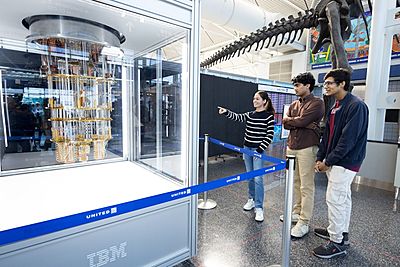Traditionally, one of the highlights of the summer for students in UChicago’s Collegiate Scholars Program (CSP) is the chance to experience life on the Hyde Park campus. “I love going to campus, and getting to know other students from beyond my neighborhood has been great,” said Kelly Padilla, a rising junior at Northside College Prep who lives in the Belmont-Cragin neighborhood and is in her second year as a Collegiate Scholar.
Founded in 2003 and operated through the University of Chicago's Office of Civic Engagement, CSP is a three-year program designed to encourage high-achieving and underrepresented Chicago Public Schools students from all over the city to apply to and succeed at highly selective colleges and universities.
During the academic year, students participate in academic enrichment activities; during the summer, they normally come to campus to take humanities, social science, math, and science courses taught by University faculty and grad students. But this summer, with a COVID-19 shutdown order in effect, nothing was normal. For the first time, CSP classes were taught virtually.
“The transition was challenging, but it actually did provide us with some new opportunities,” said Xiaoying Liu, PhD, senior lecturer and laboratory director for molecular engineering at the Pritzker School of Molecular Engineering (PME). Liu has taught Introduction to Molecular Engineering to CSP students for five years, as part of PME’s commitment to engaging with K–12 students around the city through outreach and on-campus programs.
“We had to restructure the course almost entirely, as it was formerly half lectures and half hands-on,” Liu said. So she adapted: Some of this year’s experiments used materials found around the house, like paper and toothpicks. And when students picked up their CSP information packets at the start of the summer, their materials included an electrical circuitry kit. Students followed along with a live demo during class, then built their own circuits to light up an LED bulb and uploaded photos to the class site to explain what they observed in the process. “I found the class really engaging, even though we were working from home,” Padilla said.

Another virtual innovation that Padilla enjoyed was the introduction of in-class quizzes using Kahoot, an interactive platform that turns concept review into a game. “To make the classroom environment more constructive, I made it clear to the students their quiz scores would not be taken into the course grade,” Liu said.
“The students thought it was really fun. It gave us a way to divide the lectures into smaller pieces and give students a break, while using that time to get them to think about and relate to the lecture material.” And thanks to online video resources, this year’s students were able to get a glimpse into some facets of research for the first time, like experiments that must be done in a “clean room” controlled environment where an in-person group visit wouldn’t be practical.
As always, the class centered on real-world applications of molecular engineering that make the field relatable to high schoolers. “I’d post a few pre-lecture discussion questions while we were waiting for everyone to log on,” said Liu. “For example, how many transistors do you think are incorporated into the latest iPhone chips?” The answer (7 to 8 billion), which surprised everyone in the class, led to a discussion of nanoelectronics and photolithography techniques used to manufacture the tiny chips.
Exercises like these, led by working researchers, give students a close-up look at real jobs in the sciences that they might not have known about. Padilla had long thought she’d go into medicine and become a pediatrician, “but I feel like Intro to Molecular Engineering opened my eyes to other possibilities.” She plans to explore a science major in college, possibly at Loyola University in Chicago — a college she was able to tour virtually, along with others like Syracuse University, as part of CSP’s pivot to online offerings this year.
Liu, who holds a PhD in physical chemistry from Harvard University, said that her CSP students remind her of herself at that age. “I told my family and friends that I wished I’d had the opportunity to take a course like this in high school! I was interested in chemistry and physics, but didn’t have a clear picture of various possibilities that they might lead to. We try to show our students what it might look like to study engineering in college or pursue it as a career. We want to open a door for them to see more about the field.”



